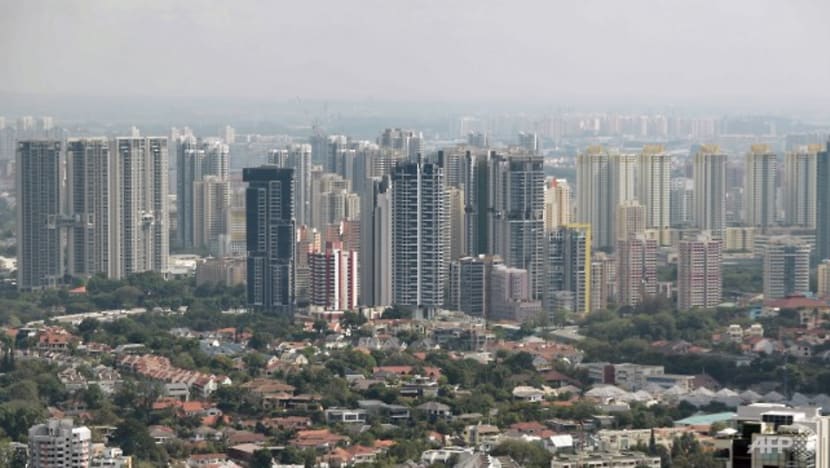Smaller homes, shorter-lease units: How Singapore's housing landscape might change amid population shifts

A view of residential housing in Singapore. (File photo: AFP)
SINGAPORE: Smaller flats and units with shorter leases could feature more heavily in Singapore’s future housing landscape, as it adapts to shifting demographics, said experts.
According to data from the latest population census, there were fewer people in each household on average, although the number of households rose over the past decade.
There were 1.37 million resident households in 2020, up from 1.15 million a decade ago. In the same period, average resident household sizes fell to 3.2 persons, down from 3.5.
READ: Household sizes shrank, median incomes rose over the past decade: Census 2020
Apart from smaller family units, a rise in singlehood and an ageing population will have implications on urban planning and housing policies, said experts CNA spoke to.
SMALLER HOMES
For a start, Singapore may need to provide more smaller homes in the public and private market, in view of the growth of smaller family units, said Dr Woo Jun Jie, a senior research fellow at the Institute of Policy Studies (IPS).
This includes smaller family nuclei, or singles and seniors living alone.
In 2020, one-person households accounted for 16 per cent of all households, while two-person households made up 22.6 per cent of them. These categories both grew by 3.8 percentage points each over the decade.
READ: Slowest decade of population growth in Singapore since independence: Census 2020
Mr Ismail Gafoor, CEO of PropNex, noted in particular that the growth of one-person households could support demand for smaller homes in the private residential market.
Another factor, he said, is whether having to care for elderly parents will “deplete the savings of younger people”.
That might eventually impact their purchasing decisions, he said. “Would they then buy smaller homes, as these are more affordable than larger units?”
But along with other experts, he acknowledged that such demand could be hampered by a desire for more spacious homes, due to “evolving work arrangements and lifestyle aspirations”.
READ: Going big on space: Buyers eye larger homes amid pandemic
This has been borne out by recent buying trends, he said. “Based on public housing resale data over the last 10 years, we have observed an increased demand for four- and five-room flats, over three-room flats, particularly in 2020.”
Ms Catherine He, the director of research for Southeast Asia at CBRE, said that while more smaller homes will be needed, there will still have to be a “good distribution of home sizes” to cater to other preferences.
CHANGING POLICIES FOR SINGLES
IPS’ Dr Woo also believes there will be a need to rethink housing allocation and grants for Housing & Development Board (HDB) flats - especially age requirements and limitations on flat sizes for singles.
Over the past decade, the proportion of singles has risen among all age groups within the bracket of 20 to 49 years old.
Currently, singles aged 35 and above can apply for two-room Build-to-Order (BTO) flats, subject to various eligibility criteria.
PropNex's Mr Ismail said housing policies for this group have become more inclusive over the decades, but added that authorities could consider letting singles buy three-room BTO flats in future.
“Some singles may need more space, for instance, an elderly single with a caregiver, or a single person who has plans to eventually get married and start a family,” he said.
But CBRE’s Ms He pointed out that Singapore’s housing policies are “pro-family” and hence “geared towards a different goal”.
“There are already policies in place to help seniors and singles secure public housing. The point of concern may lie more with the supply of these housing units,” she said.
She also noted that Singaporeans tend to turn towards the private market when their needs cannot be met by the public housing market.
READ: Singapore's private home prices up 0.9% in Q2, fifth consecutive quarterly rise
SENIOR HOUSING
Another pressing issue for housing policy stems from Singapore’s rapidly ageing population. Those aged 65 and above formed 15.2 per cent of the resident population in 2020, up from 9 per cent in 2010, according to the census.
“(Authorities can review) whether the present housing models are sufficient to cater to the needs of the ageing population, and whether there is enough supply of such housing to meet future demand from the elderly,” said Mr Ismail.
Currently, there are various options available in the public housing market for seniors, such as two-room Flexi flats and assisted living flats.
But authorities can look into whether more elderly housing options can be provided in the private residential sector, said Mr Ismail.
READ: Assisted living flats for seniors would plug gap in housing market, fulfil various needs: Experts
Ms He added: “With an aging population, we might see more projects with shorter leases to make them more affordable to the elderly.
“We might also see more sites set aside for eldercare, such as the residential care community concept for people with dementia at Sembawang or the one at Kampung Admiralty, an integrated housing project for the elderly.”
PUBLIC VS PRIVATE HOUSING
Census data also showed that more residents lived in condominiums and apartments in 2020, compared to a decade before.
The proportion of resident households living in private units increased from 11.5 per cent to 16 per cent over the period, while the proportion of those staying in HDB flats fell from 82.4 per cent to 78.7 per cent.
“The shift towards private apartments is very much a factor of the growing affluence and aspirations of Singapore residents. These are trends that will likely continue," said Dr Woo.
But he added that market forces will eventually result in a “long-term sustainable balance between public and private housing”.
Mr Ismail agreed, adding that any further shift in distributions will be “measured”.
“After all, HDB flats are considered the most affordable form of housing in Singapore and they will continue to appeal to a broad group of buyers,” he said.












